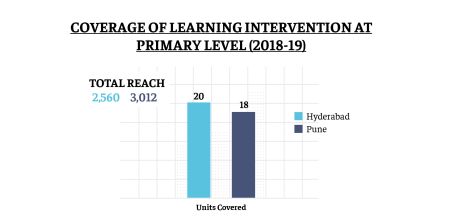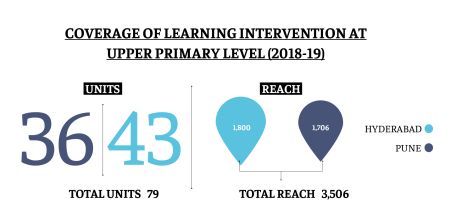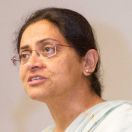It was a sweltering May morning in the city of Hyderabad, Telangana, India, and Sunita Burra was doing her best to manage in a world that had suddenly gone upside down. The year 2020 had spelt nothing but worry and danger for everyone with the onset of the global Coronavirus pandemic, COVID-19. An extremely contagious respiratory disease that could prove fatal if unchecked, COVID-19 had forced numerous nations, including India, into a lockdown since the month of March, and working remotely from home had become the new norm. However, for Sunita’s organisation and in the Indian context in particular, working remotely was proving extremely challenging, if not unfeasible in certain aspects. Sunita was a member of the Central Leadership Group at Pratham, a globally renowned non-governmental organisation that worked towards making education accessible to children of all age groups, focusing particularly on primary school education for children from low-income backgrounds. As a Program Head and National Leadership group member, it was Sunita’s responsibility to keep an eye on the various programs running in the myriad districts of the state, coordinate with other state leaders on various activities, and establish as well as develop partnerships with external organisations to make the programs a success. Ordinarily, much of Pratham’s work was field-based and involved hands-on activities like teaching, face to face interaction with communities of parents, children and teachers, and organising academic fairs, student-led exhibitions among other activities. However, none of this was possible anymore with the lockdown and compulsory home quarantine in effect, and yet it would not do to bring the programs to a halt altogether. Equipped with the understanding that the restrictions imposed due to COVID-19 would end up altering the face of the Indian education sector drastically, Pratham had already begun moving forward with a solution: aiming to reach out to students through maximum digital content, and strengthening the support system for students through increased parent participation. However, this complete redesigning of the programs was easier planned than implemented and may have been much more challenging. However, Pratham's prime corporate partners, like ADP ((Automatic Data Processing), stepped in to help.
On this particular morning in May 2020, it was the matter of these very partnerships and collaborations that occupied Sunita’s mind. Although funding was the primary support Pratham would have from a corporate partner, it was valuable when the partner involved themselves in Pratham’s programs and were able to contribute time and effort along with the money. The partner’s engagement with the programs had gained even more importance with the COVID-19 outbreak as new challenges made themselves known and impact became harder to define. However, engaging partners was not easy, and was something Sunita had to think about. In a way COVID-19 had brought forth the intent and levels of commitment Pratham’s corporate partners held towards developing the education sector and helping Pratham make a difference in the field – while several partners had continued support and engagement, some had chosen to back out of the alliance in these tough times. Some partners, though, had truly risen to the occasion and were battling the crisis hand-in-hand with Pratham. Looking back on all the previous partners Pratham had had in India since 2005, and taking into account the current COVID-19 crisis in particular, Sunita identified one that stood out brilliantly - the collaboration with ADP, a corporate specialising in providing payroll and human resource management solutions. Right from the start, it had been a smooth sail with ADP, and Sunita found that partners like ADP were precisely what her NGO needed to create the sort of impact they wanted to in India. After all, ADP had truly proven its mettle and dedication towards the partnership by providing invaluable support to Pratham’s activities in the past few months.
Lost in these thoughts, Sunita almost missed the ringing of her cell phone, managing to pick up at the last ring. “How’re you doing, Sunita?” It was Nandini Dasgupta on the other end, calling to check in with her on the progress they had made. Sunita marvelled at the perfect timing of the call- as the country-wide lead of Corporate Fundraising for Pratham, Nandini was the best person to voice her thoughts on potential corporate partnerships to. “I’m so glad you called, Nandini,” she said. “I was just going through a list of our current partnerships. I know that we have a great rapport with our existing partners, but we might face some challenges with the new reality COVID-19 has brought in. In such difficult times, the prospect of selecting a new partner whose goals and ideals align with Pratham’s is daunting.”
“I agree,” Nandini replied. “It is hard work to build and sustain such partnerships, bringing corporates close enough to the work to understand ground realities.” She paused, thinking, and then continued. “We’ve had a great run with ADP - perhaps we could use that partnership to share as an example for future collaborations?”
Sunita considered Nandini’s words. “You make an excellent point. The way ADP’s team has immersed itself completely in the project is truly inspiring and has been such a critical factor to the success we’ve seen these past few years here in Telangana. Not to mention, all the work they have been doing with us since the lockdown began in March - from providing digital resources to volunteering efforts, they’ve really stepped up and reinforced how meaningful this partnership is.”
The ADP-Pratham Alliance: Origins and Development
Sunita let her mind travel back in time to when it all began- the ADP-Pratham partnership. It was 2013 when Sreedhar Gunduboina, CSR Manager at ADP India, had approached Pratham seeking an opportunity for his organisation to work with Pratham in Hyderabad and Pune. ADP had previously partnered with a social sector organisation that aimed to eradicate poverty by providing education, access to sanitation, healthcare and specialised aid for farming. Now that the partnership had come to an end, ADP wished to make the education sector a focus for their next CSR venture. The following year, in 2014, the partnership between ADP and Pratham commenced with an aim to create and foster interventions in learning, for selected target Mandals (subdistricts in Indian cities) and schools in both Hyderabad and Pune. Over the years, the continued success of ADP’s CSR Program MIDAS (Making Impactful Difference At School) in collaboration with Pratham led to increased community outreach and higher number of schools covered. In the year 2018-19, the program worked with 80 communities across both the cities, reaching out to 35 schools in the Bandlaguda municipal region in Hyderabad, and 30 schools in Bibwewada, Pune. Out of these, 25 primary schools and ten primary schools in Bandlaguda were targeted for the intervention. Although the Early Childhood Education program and the primary grades witnessed higher outreach in Pune than in Hyderabad, in terms of intervention for upper primary (grades 5/6 to 8), community learning hub and science centres as well as the community-based children’s groups, Hyderabad saw higher levels of community outreach. However, the overall success of the program was undeniable in both Hyderabad and Pune. Sunita was pleased to note that competency goals for nearly all grades and subjects had been achieved, and in fact, the goals had been surpassed by the excellence of the work put into the program. There was a slight lag in the reading competency for standard 1-2 in Hyderabad, but Sunita was sure that with the consistent efforts put in by both Pratham and ADP, that shortcoming too would be overcome soon.


ADP’s Approach to Partnership
“Many companies can fund our programs and provide monetary help to support our work. But what makes ADP a great partner is their long-term involvement and continued interest in the work we’re doing and the lives we’re trying to improve.” Still on the call with Sunita, Nandini continued. “ADP’s approach to funding us has been quite a commitment from their side.”
“Absolutely. ADP has never hesitated to participate in whatever way they can.” Sunita agreed. The corporate had indeed aided in funding Pratham’s programs but had not limited its involvement to that alone. Sunita could think of several ways ADP had involved itself in the programs, all of which were a welcome addition to Pratham’s activities. Having funded the provision of quality infrastructure at the target schools, ADP then joined Pratham in identifying Model Schools, as they were known - total of 12 schools in Pune and 16 in Hyderabad had been covered as of early 2020. ADP was an active participant in the Model Schools Program, and the program itself was inaugurated by the global CSR head at ADP. Pratham and ADP worked together in this program to install solar panels, new toilets, design classrooms and paint the premises. ADP provided computers and helped develop Science Centres as well as Community Learning Hubs to help students gain additional skills such as proficiency in MS Office Suite and practical application-based knowledge of scientific concepts.
In addition, understanding that some particularly keen students could be provided additional support, ADP worked closely with Pratham to develop the Star Program, where select students from Hyderabad and Pune would be provided additional academic help and career guidance to help them excel in their higher studies.
Another area of active participation Sunita found particularly important was that of e-learning and digital intervention. ADP understood that digital learning was the need of the hour and would be especially beneficial to the students in Pratham’s programs since it would give them much needed technological exposure while making difficult topics easier and more interesting to learn. Thus, ADP collaborated with Pratham on the content front, and provided a number of tablets to the target communities, starting with ten communities in Pune and eventually reaching Hyderabad by 2019. ADP’s involvement in digital learning at Pratham was a clear indicator of the significant amount of thought and effort the corporate was putting into understanding the needs of the Indian education system and helping Pratham fulfil those needs effectively.
When the COVID-19 outbreak led to the country-wide lockdown, Pratham knew that their work had become more challenging and would require combined efforts with partners, as well as lots of innovative thinking to succeed. Fortunately, ADP was on the same page of thought, and understood that the mission remained the same – to reach, inspire and educate as many children as possible, using creative methods of teaching, and making the whole process a community effort – but they would have to find new ways and mediums to achieve this. Since face to face interactions were no longer possible, ADP found a new role for their volunteers to work in with Pratham: they joined the Pratham teachers in the daily process of calling up the parents of the students and engaging them in conversations ranging from different fields of learning to simple practical topics such as ‘the correct hand-wash methods,’ ‘use of face masks,’ etc. This was intended to serve a dual purpose of slowly bridging the divide created by the lack of face-to-face communication, and involving the parents even more closely in the student’s learning process. Moreover, these calls were extremely helpful for those students who lacked resources such as smartphones, computers and/or internet services in their homes. Now that traditional classroom learning would not be an option for at least several months to come, Pratham had to shift largely to digital learning- and this is where ADP’s active efforts had paid off as well. For the years 2018-19 and 2019-20, ADP had been busy at work translating various digital content into the Telugu language to help native language learners in the Telangana schools, and the 120 videos translated till date were truly coming into good use now. With continuous effort, active participation and an open mindset, ADP had demonstrated a highly collaborative spirit and had created a bond to cherish, especially in such uncertain times.
Making a Partnership for the Long-term
Sunita thought back to the previous corporate alliances Pratham had been through, and one thing was clear to her: although many corporates had supported Pratham’s programs, they had not always been deeply involved with the program on the ground. Sunita recalled how sometimes partners would suggest something different from Pratham’s existing tried and tested practices or objectives that were not part of Pratham's mandate.
However, to everyone’s delight, the partnership with ADP was different. To begin with, as Sunita recalled, ADP took the time and effort to thoroughly understand Pratham as an organisation, working with them to study the various programs in place, the techniques, procedures and practices followed at every level and for different programs as well. ADP already had a good track record with their work with the NGO they had previously collaborated with, which set them off at a good start with Pratham too, and led Pratham to hope that this alliance would be successful. Unlike many other partners, ADP expressed their wish to hit the ground running when it came to their contribution to Pratham’s programs - it was evident that not only did ADP take their CSR goals seriously, they were also keen to create real impact at the grassroots, which had always been one of Pratham’s main goals as well. Sunita could see how ADP’s commitment and enthusiasm towards the MIDAS program was reflected in their participation in the same, by their regular check-ins to ensure that the requisite infrastructure reached the schools and students, and by their presence as volunteers in many community activities. Sunita smiled as she remembered what a tremendous success the Science, Math and English melas had been last year; the students had had so much fun, their parents had taken pride in seeing how much their children had learnt, and it was an enriching experience for volunteers from both Pratham and ADP. “I do think we enjoy a healthy alliance with ADP. Apart from funding and helping obtain infrastructure, they have always been very helpful when we reached out to them for additional aid.” Sunita remarked.
“That’s true. I remember them helping us provide extra study material to meritorious students and organizing events such as success meets to motivate high-performing students further.” Nandini added. “I think it’s important to note that they are able and willing to support our programs so efficiently and wholeheartedly because they have really understood our vision and aligned their focus accordingly, while continuing to work in tandem with us to meet the needs of the Indian education system."
“I agree.” Sunita paused, searching for the words to voice out the concern that still nagged at her when she thought of future corporate alliances. She said, “We now know what qualities we are looking for in a potential corporate partner. But how do we gauge at the outset whether that corporate’s goals, vision and purpose for partnering with us match well with our interests?”
Road ahead for Pratham and Future Corporate Alliances
Sunita got off the call with Nandini, thinking hard about what Pratham could do to find strong corporate partners. Several ideas buzzed around in her head. Alternatively, should Pratham come up with a partnership note detailing the nature of collaboration and involvement in programs - or would that be too prescriptive an approach, given that programs and activities kept evolving with changing times, a fair example of which would be the current COVID-19 situation, and thus, so would the type of collaboration between Pratham and the donor?
Commentary:
The experts bring in their perspective as they respond to the key questions the case poses.
Expert Opinion: Dr. Rukmini Banerji, CEO, Pratham Education Foundation

What according to you, are some strategic motivations for Pratham or any other NGO for that matter to seek cross-sector partnerships? Do you think Pratham’s approach in this is different in any way, and if so, why?
Bringing about any kind of significant change requires many people to collaborate and work together in an aligned way. Our work with ADP is a type of direct, collaborative effort because they are there along with us at the point of interaction with students, schools and families. This type of direct work is very important because it is like a live laboratory. This is where we confront gaps and also see opportunities and available resources. This is where we iterate solutions and then track and follow through to understand its effectiveness.
Back in 2005, we started on the Annual Status of Education Report (ASER), the largest annual household survey in India with the aim to assess children’s learning outcomes across the country. From the data, we could see that although enrolment levels were high, basic learning levels were low. India is a huge country, and more than 100 -150 million children are affected by this problem, which calls for a massive solution. One of those solutions is actually through partnerships and collaborations. In fact the ASER survey itself involves partners - 600 partners, one in every district in the country. The more we work together across the board, the more we maximize our joint potential for tackling the problem, and the more likely it is that solutions are developed in diverse ways in different contexts. You can say that collaboration and partnership are in Pratham’s DNA, so to speak.
When you look at collaborations in the context of ADP, what according to you is unique about this partnership?
Something unique about ADP is that they have always been up to facing challenges with us from the word go. This is a quality we seek in all potential partners. Our collaboration with ADP started the usual way- their CSR manager approached us, having heard of us from another NGO they were working with. But over time, the partnership really grew. Perhaps the term ‘partner’ falls short to describe our relationship - ADP has stuck with Pratham through many challenges, and also we have achieved many things together.
We are currently in this crisis caused by the COVID-19 outbreak. Like they say, times of crisis test the true mettle of a partnership. What has been Pratham’s experience in these strange times with respect to existing partnerships - Have the equations changed? Have you discovered new facets about your partnerships? Also, how is it affecting your approach in seeking new partners?
Overall, I would say that I've been very impressed with almost all partners. Despite tough financial conditions, they have been very flexible and supportive. To me, what is very inspiring is also our individual donors - these are people who are not part of any organisation but who along with their family members are with us out of goodwill, have also really stepped up to offer support. As for partners like ADP, who have seen the work first hand, of course, they have stepped forward and worked with us to ensure that the investments that have been made in the project schools and communities over a period of time should not get diluted because of this external crisis. I think any strong relationship can weather a storm better than a shorter term or a weaker relationship. We are privileged and lucky that we have these kinds of relationships and I think ADP is a very good example of a solid, durable, understanding and long-run partner.
What dimensions of the partnership can be aligned such that it results in successful collaboration?
Looking specifically at the ADP-Pratham example, I think that the learning I have is that while we started small, the partnership grew steadily. Sometimes, it may take a little bit of time, but growing together is important. That means a lot of investment from both sides. On the corporate’s side, along with having faith in our efforts, spending time understanding the context and also the strategy is essential. ADP has been willing to do this. Sometimes corporates engage for a short duration, and they have big expectations. But they do not invest enough in understanding what we do, and the entire point of the partnership is missed. I am sure there have been times when the Pratham team and ADP disagreed on the next steps, but they stayed together for the long haul, through every failure and success. And often, the failures teach you more than the successes.
In addition, we also put in considerable effort into understanding the culture of the funding organisation. For some organisations, employee volunteering is very important. We have had cases where our location was at a great distance from the partner’s office, which would make volunteering difficult. But if it is very important for the corporate, we will definitely make some efforts to create a volunteering opportunity closer to them - so a lot depends on how our mutual understanding evolves.
Do you see Pratham doing things differently as compared to other NGOs, which helps to sustain and develop relationships better?
We do not do anything different for a corporate that we wouldn't be otherwise doing internally. Our style has always been inclined towards measurement, and we have found over time that corporates also prefer the same. It is rare that we develop a whole new system. But we do share our common internal measurement with any corporate that funds us. It is also a way for us to convince partners that this is the best way to measure what we do. Open communication between partners and us often helps to pave the way for what will work for both.
What are some key ingredients that can make these alliances effective in addressing complex societal issues and add to their transformative potential?
Besides mutual trust and understanding, the most important ingredient, I believe, is the recognition that there is still a lot to do. As we decide on whether to keep investing more in the same location, or taking our learnings and know-how and applying it to new areas, both Pratham and ADP agree that there is a long way ahead. Currently, ADP is comfortable with us doing intensive work in schools in Pune and Hyderabad. The decision to proceed this way was a joint one, but I think the bedrock of such an alliance and its success is the trust and the long-run nature of the investment.
What is a key takeaway or a piece of advice for someone seeking a potential corporate partner for a societal problem?
My advice would be to start with a small step, a collaboration for a year or so, that allows the organisation and the corporate partner to feel each other out, get a sense of their commitments and level of interest. Then the partnership can move forward, aligned towards long-term goals. Another quality to look for in a partner is the willingness to stay alongside through thick and thin. Investing time and energy in the program is essential, as one can then gauge whether the partnership is likely to work or not. Besides, mutual trust and active participation on the partner’s side shows that they are involved and will support your program through tough times, like the situation we are currently in.

According to you, what are some strategic motivations for ADP (and/or other corporates) to seek cross-sector partners?
When we started this programme about ten years back, we realized that India, as an economy and as a country, is not a very educated society, but education can open up many avenues for employment. We believe that education is the foundation that can lead to a lifestyle change for people in India and also contribute to the country’s growth. Therefore, we chose to contribute to the education sector. We were looking for a partner whose efforts were specially directed to the grassroots of the education sector. We started with more than one partner, but with time, we realized that the values that we bring to the table are very similar to those of Pratham’s. As the corporate partner, we did not want to just supply the funds and withdraw. Our motivations were to do something for the society and to be very involved in the process. Pratham really gave us the opportunity to work closely with them, to be actively involved, and to express our views. They have always been very open to our thoughts and ideas as well. They were and continue to be one of the best in the sector and add lots of value through their focus on primary to high school education. This focus was important to us because we were eager to contribute, but at the same time did not want to spread ourselves thin. I think these are some key factors that have helped extend our partnership over time and made the collaboration meaningful for us.
What dimensions of the partnership can be aligned such that it results in a successful collaboration?
For every organisation partnering with the social sector, I believe that program management, close monitoring and two-way actionable feedback are important practices. Equally important is keeping an open mindset, demonstrating a willingness to listen, and defining a clear-cut goal in terms of what the partner is actually providing us. These dimensions are what will take us forward. Without this understanding in the relationship, the agenda is constantly driven by only one party and there is cause for conflict. In our case, with Pratham, we have defined our goals, interests and organisational frameworks very clearly. With potential partners in the social sector as well, these dimensions will form the basis of our relationship.
In your experience, what are typical challenges that arise and how do you think you have addressed those issues?
In the Bandlaguda region, we have about 30-35 schools that we are currently working with. Over a period of time, sustaining the interest of those schools, and also our volunteering effort is something that I continue to see as a challenge. These issues are further complicated by factors such as attrition and new people joining the organisation. In terms of challenges, we face them jointly with Pratham. How relevant are we in terms of our curriculum? What is it that we can do for early-stage learning, which is more computer-based and technology-oriented? I believe Pratham has the potential to help us here, and it is a challenge that I hope we can overcome with their assistance over time. Another challenge I see, which is more sector-wide, is that many of ADP’s peers in the industry are spending their time, effort and money in areas that they are currently operating in, and those areas are often ones that do not require much investment. In our case, Pratham has helped us identify and reach smaller, more remotely located communities and offer them our combined support and resources, but for others, without the right kind of partnership, it may be very tough to gauge true impact and make progress.
What would be your advice to someone seeking to partner with the third sector for a societal problem?
Quite honestly, for a partnership like this to succeed, the organisation needs to have a clearly demarcated role that they will play. For example, in ADP’s case, the kind of technical support we can provide, and the extent of volunteering we can do is very important. Many companies do this as this is also a regulatory requirement. However, to create a real social impact, it is important to keep in mind the company’s culture and core values. Organisations should try to marry these values with the values of those they are seeking to partner with. Our partnership with Pratham works so well because our core values are so similar and we have defined and aligned them to make it work. Another important aspect to seek in a partner is transparency and open communication. Pratham is always open to audits and their way of working is very transparent, which inspires a sense of trust between us.
I would also recommend social sector organisations to be a little bit more demanding as partners. They are the ones who are essentially exploring the space, and some of them are true masters in their field. So they should not hesitate to be more demanding regarding what they want from a company. This would be my request from my partners and from my audience.
Expert Opinion: Professor Kiran Pedada, Assistant Professor, Marketing, Indian School of Business

What according to you are some strategic motivations for Pratham and other NGOs to seek cross-sector partners? Do you think Pratham’s approach appears different in any way, and if so, why?
When I work on alliances, I like to use a theory called the Resource Advantage Theory, or R-A theory. This theory helps us understand the strategic motivations behind forming alliances in general, and it helps us explain what makes alliances successful. According to R-A theory, alliances, such as the alliance between Pratham and ADP, help both the organisations access basic resources (financial support, infrastructure, etc.) and/or higher-order resources (skills, capabilities, etc.). Therefore, organisations like Pratham or ADP form these cross-sector alliances or partnerships to achieve mutually compatible goals which would have been difficult to achieve on their own. The alliance helps to bring in multidimensional support in the form of
- better access to markets,
- financial resources,
- technological resources and
- human resources.
For example, Pratham’s alliance with ADP has led to increased community outreach in 2018-19. About 80 communities across two cities, Hyderabad and Pune, have benefitted. ADP has provided financial support to improve the infrastructure at schools, help develop science centres, and Community Learning Hubs. ADP has provided technological support, especially in terms of e-learning and other digital interventions. Moreover, what is so unique about this alliance, particularly in light of the COVID-19 crisis, is that ADP has invested human resources, in terms of volunteers, to work with Pratham and engage with the students' parents and the students themselves. I think these are the four strategic motivations behind this kind of alliance.
What dimensions of the partnership can be aligned such that it results in successful collaboration?
One of the most important dimensions that should be aligned for successful collaboration is with respect to the goals. In this case, Pratham was seeking better reach and access to school children from lower-income groups and to provide quality education for them. Meanwhile, ADP wanted to focus on doing something for the society, preferably in the learning and education space by creating and fostering, not by distant interventions. Thus I believe that the alignment of goals is a very important dimension of successful collaboration, which also falls in line with the R-A theory explanation.
The second aspect here is about alignment of core values. In the Pratham-ADP alliance, both the organisations defined their core values and took time to understand how they were aligned with each other. Many alliances fail because their goals are not aligned. In this case, given that Pratham is working in education, it is incredible that ADP also involved themselves in the collaboration. Mostly in these partnerships, the corporate provides financial support, and does not go beyond that, they do not put in their time and effort. But ADP did.
Another important dimension of a successful collaboration is trust—trust is not bought, it has to be built. Likewise, one has to show commitment by involving themselves in the partnership fully. The final aspect is communication—communicating with the partner with regards to the goals one wants to achieve, the challenges being faced is crucial, since transparent communication is a key for a successful collaboration.
What are some key ingredients that can make these alliances effective in addressing complex societal issues and adding to the transformative potential?
I believe that in these alliances, unless one understands the problem, the causes behind the problem, and what may actually solve it, it is not possible to address any complex societal issues. Pratham has been highly successful in understanding the challenges deeply, particularly at the early education and secondary education levels, and has been able to provide solutions in terms of educational programs and vocational training. Naturally, NGOs invest a lot of time in understanding these issues, but one of the key ingredients of these alliances between corporates and NGOs is that the corporate must also have a good understanding of the same. If one considers India, corporates have a very long history of supporting NGOs - but the question is, are they engaging in these interventions because of the government mandate, or are they wholeheartedly looking at contributing to the society? In the Pratham-ADP case, both the organisations have a very deep understanding of the problem and that is why they have been able to come up with a spectrum of solutions. What I also see is that there is communication between the two partners—given that Pratham is in the field, they understand these problems the best, so they have to communicate these to the corporate partner. What problems are faced, and how can these be addressed? What kind of involvement and support are they expecting from the corporate partner? I would say that these are the key ingredients that can make these alliances effective and can address these challenges.
Times of crisis test the true mettle of a partnership. What have you witnessed in these unprecedented times with respect to existing partnerships, and for NGOs, which are seeking new ones?
There has been some research recently on how partnerships have responded to the financial downturn because of COVID-19. The research suggests that alliances formed for value extraction, or rather, value appropriation have survived during the crisis, and alliances that were formed for value creation, such as for research and development, failed to do so. This is because value appropriation-oriented alliances were formed to expand market reach and are essentially revenue-generating, which helps both the partners.
Corporate-NGO partnerships have flourished particularly since the government-mandated corporate social responsibility in 2014. In this COVID crisis, all the corporates have been working hard to support relief efforts, and I observed that the alliances with NGOs that are focusing on the fields of health and safety are doing particularly well currently. However, those focused on other areas have been impacted negatively. This poses several challenges for such NGOs and partnerships in these trying times.
What would be your advice to an NGO seeking a potential corporate partner for a societal problem?
I think NGOs should seek more time and involvement from the corporate, not merely funding, because the COVID-19 pandemic has also led to an economic crisis for many corporates, and they are not certain any longer as to how much financial support they can offer. However, NGOs should continue to seek financial support alongside to help them maintain their core competence to sustain themselves and continue to operate. Currently, due to the pandemic, they may not be able to increase their reach, but they can sustain the reach they already have. Thus, I believe that both financial support and corporate participation are important for an NGO to seek.
I would like to use the R-A theory here again—the whole purpose of working with a partner is that each partner brings some unique resources to the table. For an NGO, it is important to (1) understand what these resources are, (2) understand and articulate clearly what the end goal of this partnership should be and (3) recognise the impact it aims to create.
How important do you think is the role of reporting and monitoring in such alliances? How should both partners approach this?
Alliance planning is very important. One of the practices that these partners should ideally come up with as soon as they enter an alliance is creating a guiding principle or a framework which includes reporting requirements, monitoring, and the expectations from each of the partners in terms of the resources that they are bringing, as well as the kind of engagement that is expected from the partner. I would recommend developing guidelines for communication between the partners as well. This would include setting up meetings where the partners can share reports and get a chance to seek support for anything they need. I believe that would be a good way of managing such aspects of the partnership.











